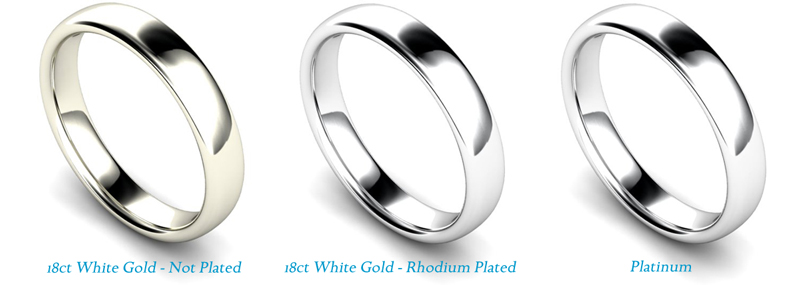People come in to see me all the time looking for their engagement and/or wedding rings, many want white gold or platinum but few know the difference between the two metals except the price.
If you're unsure, consider these differences before you make a decision.
18ct White Gold: All gold is naturally yellow in colour; it will not tarnish, corrode or rust. The purity of gold is measured in carats, which are expressed in 24ths. Therefore, 24-carat gold is pure. Pure gold is way too soft to be used for jewellery, so it is mixed with other metals to alter its strength. 18-carat gold is 75% gold and 25% other metals and is much better suited for use in rings. It is these other metals that can change the colour from yellow to white(ish). The other metal used in white gold is palladium. Although this is effective it is still not truly white and while some may like this warmer colour (see below) most prefer a true white colour so white gold jewellery is rhodium plated to give this appearance. While this works it will eventually rub off and need re-plating after 12-24 months at a cost of around £40 a time.
Care: Keep gold jewellery away from chemicals and cleaning fluids to reduce daily scratches and prolong its lustre. Wash the jewellery gently with a soft-bristled brush using a solution of detergent-free soap and warm water. Store gold pieces separately in their original boxes or soft cloth bags to protect them from the elements.

950 Platinum: A naturally white metal (looking similar to silver), but unlike gold it is used in jewellery in almost its pure form (95% pure). The other 5% is usually made from other metals such as palladium or rhodium. This is added to actually make the metal softer so it can be fashioned into jewellery. Its durability is what makes Platinum so popular. It is so strong that it doesn't splinter or whittle away like other metals.While it is the strongest of jewellery metals, platinum can still scratch with everyday wear. This produces sheen unique to platinum, called a patina. Many people prefer this finish. Those who prefer the shiny reflective look need only polish their jewellery to return it to its original lustre. Platinum does not need to be Rhodium plated like white gold.
Platinum usually costs roughly 2 times as much as the same piece of jewellery made in gold. This is due to the extreme heat and techniques necessary for its manufacture, as well as its density which makes it somewhat heavier than gold. A platinum ring is 1.4 times heavier than the same item in 18ct gold.
Care: Platinum requires little care - a soft bristled brush with a solution of soap and water is all that is needed to maintain the metal's lustre.
Pros and Cons:
| 18ct White Gold | 18ct White Gold | Platinum | Platinum |
|---|---|---|---|
| Pros | Cons | Pros | Cons |
| Less expensive | Needs re-plating | Naturally white | More expensive |
| Won't tarnish | Easily damaged | Won't tarnish | Difficult to repair |
| Easy to repair | Wears away | 95% pure | Heavyweight |
| Easy to polish | Lightweight | Won't wear away | |
| 75% pure | Needs care when storing | Requires little care | |
| Lightweight | Heavyweight |
In summary then, if you like the warm colour of the non-plated white gold then go for it, you can spend a bit more money on the diamond if its an enagagement ring you are after but if you like the true white colour then you have to go for platinum, it may be more expensive now but it will save you money in the long term.
Confidently yours,
Alexander
